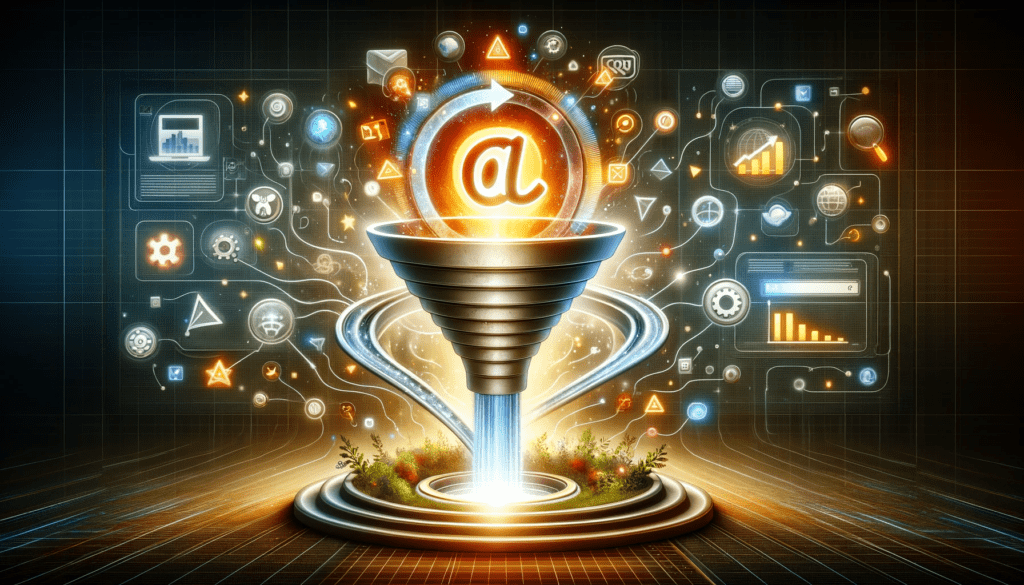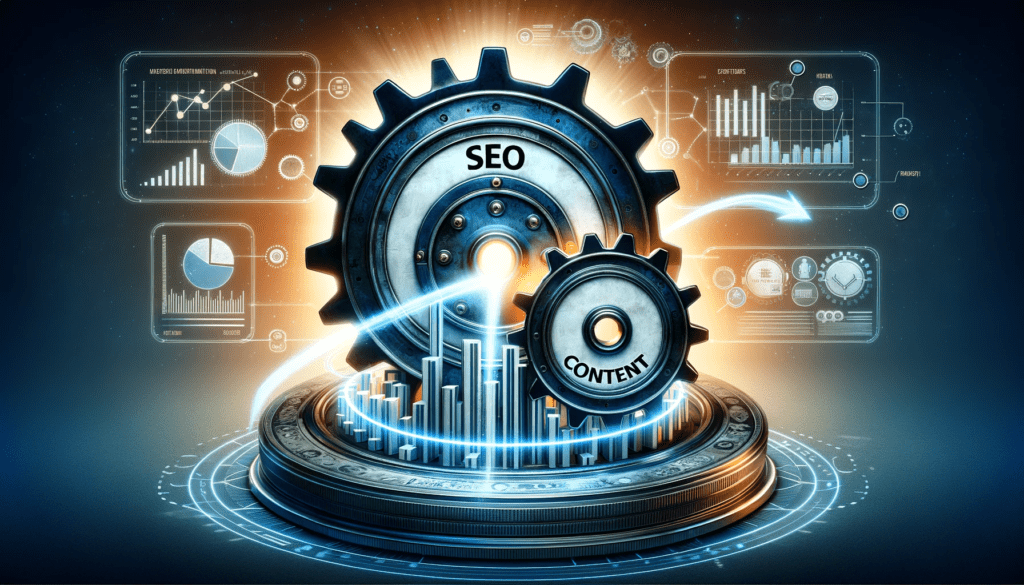
- I. How SEO and Content Drive SaaS Success
- II. Unpacking the SaaS Sales Funnel
- III. The SEO Foundation
- IV. Content Strategy for Awareness
- V. SEO and Content in the Middle of the Funnel
- VI. Nurturing Leads with Content
- VII. Closing the Deal: SEO and Content in the Conversion Stage
- VIII. Post-Sale Engagement and Retention
- IX. Measuring and Optimizing Your SEO and Content Efforts
- X. Master SaaS Funnels: Align, Optimize, Grow
I. How SEO and Content Drive SaaS Success

In the ever-evolving landscape of Software as a Service (SaaS), two critical elements stand out as driving forces behind success: Search Engine Optimization (SEO) and content.
Understanding the pivotal role these factors play in the SaaS sales funnel is essential for companies looking to thrive in this competitive domain.
This section will delve into the significance of aligning SEO and content strategies with the SaaS sales funnel and why this alignment matters profoundly for SaaS companies.
SaaS businesses have witnessed exponential growth over the years, and this trend shows no signs of slowing down.
With the increasing number of companies vying for the attention of potential customers, standing out in the digital crowd has become more challenging than ever.
This is where the synergy between SEO and content comes into play, forming the backbone of a successful SaaS sales funnel.
Why Alignment Matters for SaaS Companies
At its core, the alignment of SEO and content goals with the SaaS sales funnel enables companies to streamline their customer acquisition and retention processes.
It’s about creating a seamless journey for users, from the moment they become aware of your product to the point where they advocate for it.
By aligning these strategies, SaaS companies can achieve several critical objectives:
- Enhanced Visibility: SEO ensures that your website ranks high in search engine results, making it easier for potential customers to find you when they start their search.
- Educated Prospects: Content plays a vital role in informing and educating prospects about your product’s value and benefits. It helps users make informed decisions during the consideration stage.
- Lead Generation: Strategic content creation supported by SEO tactics generates leads, allowing companies to build a pool of potential customers interested in their offerings.
- Conversion Optimization: SEO techniques optimize the conversion path, ensuring that users who are ready to make a decision can do so seamlessly.
- Customer Retention: Beyond acquisition, SEO-driven content continues to engage and support users post-purchase, fostering loyalty and reducing churn rates.
- Data-Driven Growth: The alignment allows companies to gather valuable data and insights at each stage of the funnel, enabling data-driven decisions for continuous improvement.
In essence, aligning SEO and content goals with the SaaS sales funnel is not just an option but a necessity for companies aiming to thrive in this competitive environment.
This article will explore how to effectively achieve this alignment, step by step, to create a roadmap for sustainable growth in the SaaS industry.
II. Unpacking the SaaS Sales Funnel

In our journey to align your SaaS strategies with SEO and content goals, it’s essential to begin by thoroughly understanding the SaaS sales funnel.
This section will provide you with insights into the stages and components of a typical SaaS sales funnel, along with the critical mapping of the customer journey from awareness to advocacy.
Defining the Stages and Components of a SaaS Sales Funnel
The SaaS sales funnel is a structured representation of the customer’s journey, from the moment they become aware of your product to the point where they become loyal advocates.
Let’s break down the stages and components:
- Awareness: This is the top of the funnel (TOFU) stage where potential customers first discover your product or service. It involves creating brand awareness and capturing the attention of your target audience.
- Interest: In the middle of the funnel (MOFU), potential customers have expressed some level of interest in your offering. They are exploring their options and seeking more information.
- Consideration: The middle of the funnel (MOFU) is where prospects evaluate your product in more detail. They are considering whether it meets their specific needs and requirements.
- Conversion: This is the bottom of the funnel (BOFU) stage where prospects decide to become customers by making a purchase or taking another desired action, such as signing up for a demo.
- Retention: Post-sale engagement is crucial for SaaS companies. Keeping customers satisfied and engaged is essential for long-term retention.
- Advocacy: Loyal customers who have had a positive experience with your product can become advocates. They promote your brand, refer others, and contribute to your growth.
Understanding these stages and their components is the first step in aligning your SEO and content strategies with your SaaS sales funnel.
Each stage requires a unique approach to content and SEO to effectively guide customers along the journey.
Mapping the Customer Journey from Awareness to Advocacy
Mapping the customer journey is about understanding the path that leads users from the initial awareness of your product to becoming dedicated advocates.
At each stage, your content and SEO strategies should address specific user needs and questions.
- Awareness: Users are looking for information and answers to their initial questions. Your SEO efforts should focus on capturing relevant search queries, and your content should provide valuable insights without being overly promotional.
- Interest: At this stage, users seek more in-depth information. Your content should address their growing interest, and SEO should guide them to informative resources.
- Consideration: Users are comparing your product to alternatives. SEO should emphasize product differentiators, and content should provide detailed comparisons and case studies.
- Conversion: This is the critical moment when users decide to take action. SEO should facilitate a smooth path to conversion, and content should instill confidence and remove any remaining obstacles.
- Retention: To keep customers engaged, your content should focus on product education and updates, while SEO should ensure they can easily find support and resources.
- Advocacy: Encourage satisfied customers to share their positive experiences. SEO can support this by helping advocates find opportunities to promote your brand, and content can provide advocacy resources.
By unpacking the SaaS sales funnel in this way, you’ll gain clarity on how SEO and content can be strategically aligned at each stage to guide users toward conversion and advocacy.
In the following sections, we’ll delve deeper into the specific strategies for each stage to achieve this alignment successfully.
III. The SEO Foundation

To effectively align your SaaS sales funnel with SEO and content goals, you need a sturdy SEO foundation.
In this section, we’ll explore the steps to build a strong SEO base for your SaaS website and how to leverage keywords and on-page optimization for better online visibility.
Building a Strong SEO Base for Your SaaS Website
Your SaaS website is the digital storefront where your potential customers first encounter your brand. To make a lasting impression and drive organic traffic, consider the following:
- Website Structure: Ensure your website has a logical and user-friendly structure. Clear navigation, intuitive menus, and well-organized content are essential.
- Mobile Optimization: Given the prevalence of mobile devices, your website must be mobile-friendly and responsive. Google prioritizes mobile-first indexing.
- Site Speed: Speed matters. A fast-loading site not only improves user experience but also positively impacts SEO. Compress images, use efficient coding, and consider a content delivery network (CDN).
- Technical SEO: Pay attention to technical aspects such as XML sitemaps, robots.txt files, and schema markup. These elements help search engines understand and index your content better.
- URL Structure: Use clean, descriptive URLs. Avoid long strings of numbers or irrelevant characters. Include keywords where appropriate.
- Secure Connection (HTTPS): Google prefers secure websites. Ensure your site uses HTTPS to encrypt data transfer, and obtain an SSL certificate.
- User Experience (UX): A seamless user experience matters for SEO. Reduce bounce rates by providing valuable content and easy navigation.
Leveraging Keywords and On-Page Optimization for Visibility
Keywords are the foundation of SEO. They are the words and phrases your potential customers use when searching for solutions like yours. Here’s how to use them effectively:
- Keyword Research: Identify relevant keywords for your SaaS product. Consider using tools like Google Keyword Planner, SEMrush, or Ahrefs to discover high-traffic and low-competition keywords.
- On-Page Optimization: Incorporate selected keywords naturally into your website’s content. Optimize meta titles, descriptions, and header tags. Avoid keyword stuffing, as it can harm your rankings.
- Quality Content: Create high-quality, informative, and engaging content around your chosen keywords. Content should provide value to your target audience and answer their questions.
- Long-Tail Keywords: Don’t overlook long-tail keywords, which are longer and more specific phrases. They often have less competition and can attract highly relevant traffic.
- Local SEO: If your SaaS product serves a specific geographic area, optimize for local SEO. Create a Google My Business listing and ensure consistent NAP (Name, Address, Phone number) information.
- Voice Search Optimization: With the rise of voice-activated devices, optimize for voice search by focusing on conversational and natural language queries.
- Regular Updates: Search engines favor fresh content. Regularly update your website with new blog posts, articles, or product information.
By establishing a robust SEO foundation and strategically incorporating keywords and on-page optimization, your SaaS website will have a higher chance of ranking well in search engine results pages (SERPs).
This, in turn, can attract more organic traffic and guide users into your sales funnel. In the following sections, we will delve deeper into the content strategies and SEO tactics for each stage of the funnel.
IV. Content Strategy for Awareness

In the earlier sections, we’ve established the importance of a solid SEO foundation. Now, let’s dive into crafting a content strategy tailored for the awareness stage of your SaaS sales funnel.
This stage is where potential customers first encounter your brand, so it’s crucial to create content that captures their attention.
Creating Content That Captures the Attention of Potential Customers
- Educational Blog Posts: Start by creating informative blog posts that address common pain points and questions your target audience may have. These posts should offer valuable insights and solutions related to your SaaS product without directly promoting it.
- Engaging Social Media Content: Leverage platforms like Facebook, Twitter, LinkedIn, and Instagram to share engaging content. Use a mix of visuals, infographics, and short video clips to grab the audience’s attention.
- Thought Leadership Articles: Establish your company and team as thought leaders in the industry by publishing in-depth articles on industry trends, challenges, and innovative solutions. This not only positions your brand as an authority but also piques the interest of potential customers seeking expertise.
- Infographics and Visual Content: Visual content often performs well in capturing attention. Create visually appealing infographics and images that convey key information or statistics related to your industry or product benefits.
- Webinars and Podcasts: Hosting webinars or podcasts on relevant topics can draw in an audience looking for in-depth knowledge. Promote these events across your online channels to generate awareness.
- Case Studies: Showcase real-world examples of how your SaaS product has helped businesses or individuals overcome challenges. Case studies offer social proof and demonstrate the practical application of your solution.
- E-books and Whitepapers: Create comprehensive e-books or whitepapers that delve into industry-specific issues and provide actionable insights. Require users to provide their email addresses to access these resources, thus generating leads.
- Guest Posting: Collaborate with industry influencers or complementary businesses for guest posting opportunities. Sharing your expertise on reputable websites can expand your reach and introduce your brand to a wider audience.
The Power of Blog Posts, Social Media, and Educational Content
Your blog plays a central role in your content strategy for awareness. Regularly publishing informative and relevant blog posts not only attracts organic traffic but also keeps your website fresh and engaging.
These posts serve as entry points for potential customers, guiding them further into your sales funnel.
Social media platforms are invaluable for distributing your content and engaging with your audience.
Share your blog posts, visual content, and thought leadership articles on social channels to maximize visibility.
Encourage sharing and interaction to broaden your reach.
Educational content serves as the cornerstone of your awareness stage efforts. By providing value and addressing the needs of your target audience, you establish trust and credibility.
This trust forms the basis for guiding users to the middle and later stages of your SaaS sales funnel, which we’ll explore in subsequent sections.
V. SEO and Content in the Middle of the Funnel

As potential customers move from the awareness stage to the consideration stage, your approach to SEO and content must adapt accordingly.
This stage is where users are actively evaluating solutions, so your content should guide them towards choosing your SaaS product.
Guiding Users from Awareness to Consideration with SEO
- Targeted Keywords: Revisit your keyword strategy to include terms that reflect users’ intent to consider SaaS solutions. Incorporate phrases like “best SaaS for [specific use case]” or “[your product] alternatives” into your content.
- Comprehensive Guides: Develop comprehensive guides that compare your SaaS product to competitors. Highlight your unique features and benefits, addressing the questions and concerns potential buyers may have.
- Case Studies: Create case studies that showcase how your SaaS solution has solved specific problems for existing customers. Real-world success stories provide compelling evidence of your product’s value.
- Webinars and Demos: Offer webinars and live product demonstrations that give potential customers an in-depth look at your solution. These interactive sessions can address their questions and offer a deeper understanding of your product’s capabilities.
- Interactive Content: Consider interactive content like quizzes or assessment tools that help users identify their specific needs. Based on their responses, you can provide tailored recommendations, positioning your product as the ideal solution.
Developing High-Value Content Offers for the Middle Stage
The middle of the sales funnel is all about providing value and building trust.
Your content should focus on addressing the specific pain points and requirements of potential customers, positioning your SaaS product as the best solution.
- Comparison Content: Create detailed comparisons between your SaaS product and competitors. Highlight the advantages and unique selling points that set your solution apart.
- In-Depth E-books: Offer comprehensive e-books that dive deep into industry-specific challenges and how your product can address them. These resources should provide valuable insights that users can’t easily find elsewhere.
- Expert Webinars: Host webinars featuring industry experts discussing trends, challenges, and solutions. This not only positions your brand as a trusted authority but also attracts users seeking knowledge.
- Interactive Product Tours: Develop interactive product tours that allow potential customers to explore your SaaS solution’s features and benefits at their own pace.
- Email Segmentation: Segment your email list based on user behavior and engagement. Tailor your email content to match each user’s stage in the consideration process, providing relevant information and nudging them closer to a decision.
By strategically incorporating these SEO and content tactics into the middle of your sales funnel, you can effectively nurture leads, address their specific needs, and guide them toward making an informed decision.
In the next section, we’ll explore how to further nurture and convert these leads into customers during the conversion stage.
VI. Nurturing Leads with Content

Moving down the SaaS sales funnel, we arrive at the crucial stage of lead nurturing. At this point, potential customers have shown interest and are considering your SaaS solution.
To convert these leads into paying customers, a well-crafted content strategy combined with email marketing and drip campaigns can work wonders.
Using Email Marketing and Drip Campaigns to Keep Users Engaged
- Segment Your Email List: To effectively nurture leads, segment your email list based on user behavior, interests, and where they are in the decision-making process. This segmentation allows for highly targeted and personalized email campaigns.
- Educational Email Series: Create email drip campaigns that provide educational content over a series of emails. Start with introductory content and gradually dive deeper into how your SaaS solution addresses specific pain points.
- Address Common Concerns: Anticipate and address common concerns or objections potential customers might have. Use your email campaigns to provide answers and alleviate any doubts.
- Customer Testimonials: Share success stories and customer testimonials via email. Hearing about the positive experiences of others can boost confidence and trust in your product.
- Exclusive Offers: Consider offering exclusive discounts or trials to leads in your email campaigns. Limited-time offers can create a sense of urgency and drive conversions.
Crafting Compelling Content for Lead Nurturing
- Whitepapers and Reports: Offer in-depth whitepapers and industry reports that provide valuable insights and data relevant to your potential customers. This content establishes your authority and expertise.
- Interactive Content: Integrate interactive elements into your content, such as quizzes or assessments, to engage leads. These tools can help potential customers understand their needs better and highlight your SaaS solution as the answer.
- How-To Guides: Create detailed how-to guides that walk users through common tasks or challenges in your industry. Position your product as the solution they need to simplify these tasks.
- Personalized Content: Leverage user data and behavior to personalize content recommendations. Show leads content that aligns with their interests and stage in the buying process.
- Educational Videos: Video content is highly engaging. Produce videos that explain complex concepts, showcase your product in action, or feature interviews with industry experts.
In the middle of the sales funnel, lead nurturing is about building relationships and trust. By delivering valuable content through email marketing and drip campaigns, you can keep potential customers engaged and informed.
In the next section, we’ll delve into strategies for closing the deal as leads approach the conversion stage.
VII. Closing the Deal: SEO and Content in the Conversion Stage

As we move further down the SaaS sales funnel, the focus shifts to converting interested prospects into paying customers.
This is where strategic SEO techniques and persuasive content play a pivotal role in driving conversions.
In this section, we will explore how to optimize your SEO and content efforts to seal the deal with potential customers.
Driving Conversions with Strategic SEO Techniques
- Optimize Landing Pages: Ensure that your landing pages are well-optimized for both search engines and user experience. This includes using relevant keywords, clear and compelling CTAs, and mobile-friendly design.
- A/B Testing: Continuously test and refine your landing page elements, such as headlines, copy, and CTAs. A/B testing helps you identify what resonates best with your target audience and leads to higher conversion rates.
- Local SEO: If your SaaS business serves specific regions or markets, leverage local SEO strategies. This includes optimizing for local keywords, creating Google My Business listings, and encouraging customer reviews.
- Schema Markup: Implement schema markup to provide search engines with structured data about your product or service. This can enhance the visibility of rich snippets in search results, making your offerings more appealing to potential customers.
- Page Speed Optimization: Slow-loading pages can deter users from converting. Ensure your website loads quickly by optimizing images, using content delivery networks (CDNs), and reducing unnecessary scripts.
Creating Content That Removes Final Obstacles to Purchase
- Case Studies and Success Stories: Showcase real-life examples of how your SaaS solution has solved problems or delivered results for existing customers. Case studies build credibility and demonstrate your product’s value.
- Comparison Content: Create content that compares your product to competitors, highlighting your unique selling points. Prospective customers often conduct thorough research before making a decision.
- Free Trials and Demos: Offer free trials or product demos to let users experience your SaaS solution firsthand. Ensure these offers are prominently displayed on your website and supported by informative content.
- FAQ and Support Content: Anticipate common questions and concerns potential customers might have before making a purchase. Develop comprehensive FAQs and support content to address these issues.
- Trust Signals: Display trust signals like industry certifications, security badges, and customer testimonials prominently on your website. These elements instill confidence in potential customers.
In the conversion stage, your SEO efforts need to be finely tuned, and your content should focus on removing any final obstacles that may be holding back a potential sale.
Next, we’ll explore how post-sale engagement and content retention strategies are essential for keeping customers satisfied and loyal.
VIII. Post-Sale Engagement and Retention

Once a customer has converted and subscribed to your SaaS product, the journey is far from over. In fact, it’s just the beginning of a new phase in the customer relationship.
Post-sale engagement and retention are critical for ensuring long-term success and recurring revenue.
This section delves into how SEO-driven content and customer-focused strategies can help you retain and nurture your customers effectively.
Retaining Customers with SEO-Driven Content
After the initial purchase, maintaining regular engagement with your customers becomes crucial. This is where a well-crafted content strategy supported by SEO can make a significant impact:
- Customer Onboarding Content: Develop onboarding materials, such as tutorials, how-to guides, and videos, to help new customers get the most out of your product. Optimizing this content for search engines ensures that customers can easily find and use it.
- User Community Building: Encourage the creation of user communities, forums, or discussion boards where customers can connect, share experiences, and seek help. SEO can aid in driving traffic to these community spaces.
- Feedback Loops: Actively collect feedback from your customers through surveys, reviews, and direct communication. Use this feedback to create content that addresses their pain points and needs, showing that you value their input.
- Regular Updates and Announcements: Keep your customers informed about product updates, new features, and company news through blog posts, email newsletters, and social media. These updates can be optimized for search visibility.
- Educational Webinars and Events: Host webinars, workshops, or virtual events that provide value to your customers. Promote these events using SEO techniques to ensure they reach your target audience.
The Role of Content in Customer Success and Retention
- Customer Success Stories: Showcase success stories of existing customers who have achieved significant results with your SaaS product. These stories serve as powerful testimonials and can be optimized for search engines.
- Renewal Reminders: Use content to remind customers about upcoming renewals or subscription expirations. Highlight the value they’ve gained from your product and offer incentives for renewing.
- Exclusive Content for Subscribers: Reward loyal customers with exclusive content, resources, or discounts. This not only incentivizes them to stay but also makes them feel valued.
- Content Personalization: Leverage customer data to personalize content recommendations. Suggest articles, resources, or features that align with their usage patterns and preferences.
- Feedback Implementation: Demonstrate to customers that their feedback matters by implementing suggested improvements and updates. Create content around these enhancements to keep customers informed.
By employing SEO-driven content and focusing on customer success and retention, you can reduce churn rates, increase customer loyalty, and ultimately maximize the lifetime value of each customer.
In the next section, we’ll explore how to measure and optimize your SEO and content efforts to ensure they align with your SaaS sales funnel goals effectively.
IX. Measuring and Optimizing Your SEO and Content Efforts

To ensure the successful alignment of your SaaS sales funnel with SEO and content goals, it’s essential to measure and optimize your efforts continuously.
This section explores the key metrics and KPIs you should monitor and how to make data-driven improvements to maximize revenue.
Key Metrics and KPIs for Monitoring Funnel Alignment
- Traffic Source Analysis: Examine the sources of traffic to your website to understand which channels are driving visitors into your funnel. Key sources may include organic search, paid search, social media, email, and referrals.
- Conversion Rate: Calculate the conversion rate at each stage of your funnel. This helps you identify bottlenecks and areas that need improvement.
- Bounce Rate: Keep an eye on your website’s bounce rate. High bounce rates indicate that visitors aren’t finding what they expected or needed, which can signal a problem in your content or user experience.
- Click-Through Rate (CTR): Analyze the CTR of your SEO-optimized content and calls-to-action (CTAs). A high CTR indicates that your content is compelling and resonating with your target audience.
- Customer Acquisition Cost (CAC): Calculate how much it costs to acquire a new customer. This metric is vital for evaluating the efficiency of your marketing campaigns.
- Customer Lifetime Value (CLV): Determine the CLV for your customers. This metric helps you understand the long-term value of each customer and guides your retention strategies.
- Churn Rate: Measure the churn rate, which indicates the percentage of customers who cancel their subscriptions. A high churn rate can offset your acquisition efforts.
- Keyword Rankings: Monitor the rankings of your target keywords in search engine results pages (SERPs). An upward trend in rankings indicates improved SEO performance.
- Content Engagement: Track user engagement with your content, such as time spent on page, social shares, and comments. Engaging content is more likely to convert visitors.
- Email Metrics: For email marketing campaigns, pay attention to open rates, click-through rates, and unsubscribe rates. These metrics help refine your email strategies.
Making Data-Driven Improvements to Maximize Revenue
- A/B Testing: Implement A/B testing for landing pages, CTAs, and email campaigns to determine which variations perform best. Use the winning versions to optimize your funnel.
- Content Gap Analysis: Regularly identify gaps in your content that align with specific stages of the funnel. Create new content to fill these gaps and address user needs.
- Keyword Optimization: Continuously refine your keyword strategy based on keyword performance data. Focus on high-converting keywords and adapt your content accordingly.
- Segmentation: Segment your audience based on their behavior and preferences. Deliver personalized content and offers to specific segments to enhance engagement.
- Conversion Rate Optimization (CRO): Implement CRO techniques to improve the conversion rates of your landing pages and forms. Test various elements like headlines, images, and form fields.
- Customer Feedback Integration: Act on customer feedback by addressing pain points and enhancing your product or service. Use customer insights to shape your content and marketing strategies.
- Competitor Analysis: Regularly analyze your competitors’ strategies and adapt to industry trends. Learn from their successes and failures to refine your own approach.
By continually monitoring and optimizing your SEO and content efforts, you can adapt to changing market dynamics, customer preferences, and search engine algorithms.
This data-driven approach ensures that your SaaS sales funnel remains finely tuned to drive sustainable growth. In the concluding section, we’ll summarize the key takeaways and provide a roadmap for achieving mastery in aligning your strategies for sustainable growth.
X. Align, Optimize, Grow

In this comprehensive guide, we’ve explored the critical role of SEO and content in aligning your SaaS sales funnel for success.
From understanding the stages of the funnel to mastering SEO techniques and content strategies, you now have the knowledge and tools to create a well-optimized and efficient funnel.
Remember that alignment matters for SaaS companies because it directly impacts revenue, customer retention, and sustainable growth.
When your SEO and content efforts are synchronized with your sales funnel, you can attract, convert, and retain customers more effectively.
With the roadmap we’ve provided, you can embark on the journey of aligning your strategies for sustainable growth.
By continually measuring, optimizing, and adapting your approach based on data-driven insights, you’ll be well on your way to achieving SaaS sales funnel mastery.
Now, it’s time to put these insights into action and watch your SaaS business thrive.
Transform Your SaaS Funnel Now

Are you ready to transform your SaaS sales funnel through the power of SEO and content? Get started today and unlock the full potential of your digital marketing strategies.
If you have questions or need expert guidance, our team of professionals is here to help. Contact us to take the next step toward sustainable growth and success.